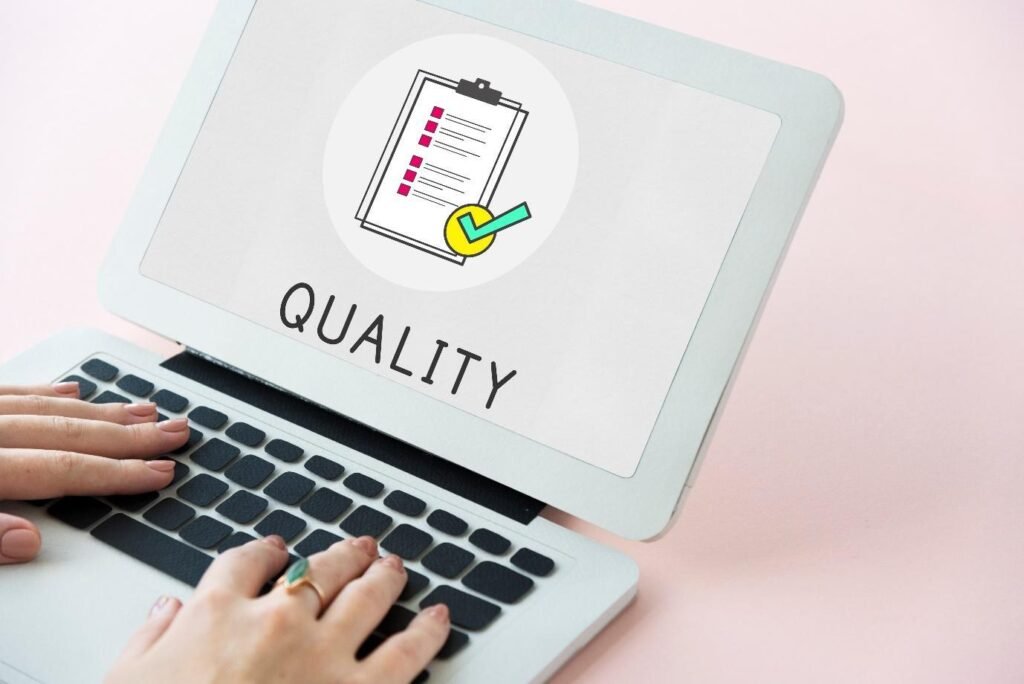Introduction
Imagine a business where every process is optimized, every product consistently meets high standards, and every customer is delighted. This is not just a dream but a reality achievable through ISO 9001 certification.
Quality Management Systems (QMS) are the backbone of modern business operations. They ensure that products and services meet customer expectations and comply with regulatory requirements. A well-implemented QMS can lead to improved operational efficiency, reduced costs, and increased customer satisfaction.
ISO 9001 certification can revolutionize a business by enhancing its quality management practices, leading to significant improvements in efficiency, customer satisfaction, and overall performance.
Understanding ISO 9001 and Quality Management Systems
A. Definition of ISO 9001:
ISO 9001 is an international standard that specifies requirements for a Quality Management System. It provides a framework for organizations to ensure they meet customer and regulatory requirements while continuously improving their processes. The standard focuses on key aspects such as customer satisfaction, process efficiency, and continual improvement.
B. Importance of Quality Management Systems:
A Quality Management System (QMS) is crucial for maintaining consistency in product and service quality. It helps businesses systematically manage and improve their processes, leading to better operational efficiency and enhanced customer satisfaction. By adhering to a QMS, organizations can identify areas for improvement, address customer complaints effectively, and ensure compliance with industry standards.
C. ISO 9001 in the QMS Landscape:
ISO 9001 is one of the most recognized and widely adopted quality standards globally. It fits into a broader landscape of quality standards by providing a versatile framework applicable to various industries. While other standards may focus on specific sectors or aspects of quality, ISO 9001 offers a comprehensive approach that can be tailored to any organization’s needs.
The Benefits of ISO 9001 Certification
- Enhanced Customer Satisfaction: ISO 9001 helps businesses better understand and meet customer needs. By establishing a systematic approach to quality management, organizations can deliver products and services that consistently meet customer expectations, leading to higher satisfaction and loyalty.
- Operational Efficiency: Implementing ISO 9001 standards streamlines processes, reduces waste, and improves resource management. This leads to more efficient operations, cost savings, and improved overall performance. By focusing on process optimization, businesses can enhance productivity and reduce operational inefficiencies.
- Risk Management: ISO 9001 emphasizes identifying and mitigating risks that could impact quality. By implementing a proactive approach to risk management, businesses can address potential issues before they escalate, enhancing resilience and stability.
- Market Competitiveness: Achieving ISO 9001 certification provides a competitive edge by demonstrating a commitment to quality and excellence. It can open doors to new markets, attract more customers, and differentiate a business from its competitors. Certification can also enhance credibility and trust with stakeholders.
The Certification Process: A Step-by-Step Guide
Achieving ISO 9001 certification involves a structured process that ensures your Quality Management System (QMS) meets the high standards required. Here’s a step-by-step guide to help you navigate through the certification journey.
A. Preparation and Gap Analysis
- Preparation: The first step in the certification process is to prepare your organization for ISO 9001. This involves understanding the requirements of the standard and evaluating your current quality management practices. Assemble a team responsible for leading the certification process and ensure they are well-versed in ISO 9001 requirements.
- Gap Analysis: Conduct a thorough gap analysis to compare your existing QMS with the ISO 9001 standard. This involves reviewing your current processes, documentation, and practices to identify discrepancies. The gap analysis helps in pinpointing areas that need improvement or alignment with ISO 9001 requirements. Create an action plan to address these gaps and set clear objectives for the changes needed.
B. Documentation and Implementation
- Documentation: Develop the necessary documentation required for ISO 9001 compliance. This includes creating or updating quality policies, procedures, and work instructions that align with ISO 9001 standards. Ensure that all documentation reflects the requirements of the standard and supports your organization’s quality objectives.
- Implementation: Once the documentation is in place, implement the revised processes and procedures throughout your organization. This involves training employees on new practices, integrating new processes into daily operations, and ensuring that everyone understands their roles and responsibilities in maintaining quality standards. Effective communication and training are crucial to ensure a smooth transition.
C. Internal Audits and Management Review
- Internal Audits: Conduct internal audits to evaluate the effectiveness of your QMS and verify that it complies with ISO 9001 standards. Schedule regular audits to assess the system’s performance and address any issues before the external certification audit.
- Management Review: Perform management reviews to evaluate the performance of your QMS. This involves reviewing audit results, customer feedback, and process performance to assess whether your quality objectives are being met. Management reviews provide an opportunity to make strategic decisions on improvements and ensure the QMS remains aligned with organizational goals.
D. The Certification Audit
- Preparing for the Audit: The certification audit is conducted by an external auditor who assesses whether your QMS meets ISO 9001 standards. Prepare for the audit by ensuring that all documentation is complete, processes are being followed, and employees are ready to answer questions about the QMS. Conduct a final internal audit to identify and correct any remaining issues.
- The Audit Process: During the certification audit, the external auditor will review your documentation, observe processes, and interview employees. They will assess compliance with ISO 9001 requirements and verify that the QMS is effectively implemented.
- Post-Audit Actions: After the audit, the auditor will provide a report detailing their findings. Address any non-conformities or areas for improvement highlighted in the report. Once all issues are resolved, the certification body will issue the ISO 9001 certification. Maintain your certification by adhering to ISO 9001 requirements and preparing for periodic surveillance audits.
Overcoming Challenges in ISO 9001 Implementation
- Common Challenges: Businesses may face challenges such as resistance to change, inadequate training, and resource constraints during the ISO 9001 implementation process. Identifying these hurdles early can help in addressing them effectively.
- Solutions and Best Practices: Overcome challenges by fostering a culture of quality, providing comprehensive training, and allocating necessary resources. Engage employees at all levels and communicate the benefits of ISO 9001 to gain their support and ensure smooth implementation.
- Support and Resources: Seek guidance from ISO consultants, attend training programs, and use online resources to support your ISO 9001 journey. Many organizations offer tools and services to assist with certification and ongoing compliance.
Conclusion
A. Recap of Key Points:
ISO 9001 certification offers numerous benefits, including enhanced customer satisfaction, improved operational efficiency, effective risk management, and a competitive market advantage. Implementing a robust QMS can lead to significant business improvements and long-term success.
B. Call to Action:
Consider ISO 9001 certification as a strategic investment in your business. Embrace the opportunity to revolutionize your quality management practices and drive excellence in every aspect of your operations.
C. Final Thoughts:
ISO 9001 certification is not just a badge of quality but a commitment to continuous improvement and customer satisfaction. By adopting this standard, businesses can foster a culture of excellence and achieve remarkable growth and success.





Thank you for your sharing. I am worried that I lack creative ideas. It is your article that makes me full of hope. Thank you. But, I have a question, can you help me?
Your point of view caught my eye and was very interesting. Thanks. I have a question for you.
Thanks for sharing. I read many of your blog posts, cool, your blog is very good.
Thank you for your sharing. I am worried that I lack creative ideas. It is your article that makes me full of hope. Thank you. But, I have a question, can you help me?
Can you be more specific about the content of your article? After reading it, I still have some doubts. Hope you can help me.
This web-based service enables instant conversion of images into JPG format, supporting common types such as JPG. All operations take place within the browser, with no need for app downloads or user accounts. Up to 20 files can be converted in a single session, improving efficiency for repetitive or large-scale tasks. Once files are processed, they are deleted from the system to maintain privacy and prevent unnecessary storage. JPEGtoJPGHERO is designed to work across all devices and browser types, offering a seamless experience whether on a computer, phone, or tablet. Its minimal layout emphasizes clarity and speed, guiding users directly to results. From resizing visuals for websites to preparing files for cloud storage, the platform handles JPEGtoJPGhero conversion with accuracy and ease. Its emphasis on simplicity and security makes it an excellent choice for both casual users and professionals who require consistent, reliable output.
https://www.enggpro.com/company/JPEGtoJPGHero
температура воды в хургаде в апреле
Сергей Бидус кинул на деньги
agencja webcam Warszawa Стань вебкам моделью в польской студии, работающей в Варшаве! Открыты вакансии для девушек в Польше, особенно для тех, кто говорит по-русски. Ищешь способ заработать онлайн в Польше? Предлагаем подработку для девушек в Варшаве с возможностью работы в интернете, даже с проживанием. Рассматриваешь удаленную работу в Польше? Узнай, как стать вебкам моделью и сколько можно заработать. Работа для украинок в Варшаве и высокооплачиваемые возможности для девушек в Польше ждут тебя. Мы предлагаем легальную вебкам работу в Польше, онлайн работа без необходимости знания польского языка. Приглашаем девушек без опыта в Варшаве в нашу вебкам студию с обучением. Возможность заработка в интернете без вложений. Работа моделью онлайн в Польше — это шанс для тебя! Ищешь “praca dla dziewczyn online”, “praca webcam Polska”, “praca modelka online” или “zarabianie przez internet dla kobiet”? Наше “agencja webcam Warszawa” и “webcam studio Polska” предлагают “praca dla mlodych kobiet Warszawa” и “legalna praca online Polska”. Смотри “oferty pracy dla Ukrainek w Polsce” и “praca z domu dla dziewczyn”.
почему акулы нападают в египте
Hi friends, its enormous post about cultureand entirely defined, keep it up all the time.
The payout system at ck222 bet is fast and fair.
Wow that was unusual. I just wrote an very long comment but after I clicked submit my comment didn’t show up. Grrrr… well I’m not writing all that over again. Regardless, just wanted to say great blog!
Trusted by pros — 88fb bet is the best casino to join
I don’t think the title of your article matches the content lol. Just kidding, mainly because I had some doubts after reading the article.
Hi, after reading this awesome piece of writing i am as well delighted to share my knowledge here with colleagues.
Experience the top rated betting site in Bangladesh at 88fb casino
Awesome! Its genuinely remarkable paragraph, I have got much clear idea concerning from this piece of writing.
Terrorism
Your article helped me a lot, is there any more related content? Thanks!
Reading your article helped me a lot and I agree with you. But I still have some doubts, can you clarify for me? I’ll keep an eye out for your answers.